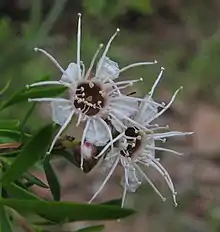Kunzea leptospermoides
Kunzea leptospermoides, commonly known as Yarra burgan, is a flowering plant in Myrtaceae, the myrtle family, and is endemic to Victoria, Australia. It is an erect shrub or small tree with narrow leaves and white flowers crowded near the ends of the branches in spring.
| Yarra burgan | |
|---|---|
 | |
| Kunzea leptospermoides growing in Donvale | |
| Scientific classification | |
| Kingdom: | Plantae |
| Clade: | Tracheophytes |
| Clade: | Angiosperms |
| Clade: | Eudicots |
| Clade: | Rosids |
| Order: | Myrtales |
| Family: | Myrtaceae |
| Genus: | Kunzea |
| Species: | K. leptospermoides |
| Binomial name | |
| Kunzea leptospermoides | |
Description
Kunzea leptospermoides is an erect shrub or small tree which grows to a height of 2–5 m (7–20 ft). The leaves are arranged alternately, narrow elliptic to lance-shaped with the narrower end towards the base, 7–25 mm (0.3–1 in) long and 1–2 mm (0.04–0.08 in) wide with a petiole about 0.5 mm (0.02 in) long. The flowers are white and crowded in leaf axils near the ends of the branches on pedicels 1–3 mm (0.04–0.1 in) long. The floral cup is about 3 mm (0.1 in) long and more or less glabrous. The sepal lobes are green with a reddish base, triangular and about 1 mm (0.04 in) long. The petals are white, almost round and about 2 mm (0.08 in) in diameter and there are 20-35 stamens which are up to 4 mm (0.2 in) long. Flowering occurs between September and December and is followed by fruit which is a capsule 3–4 mm (0.1–0.2 in) long and wide.[1]
Taxonomy and naming
Kunzea leptospermoides was first formally described in 1856 by Friedrich Miquel following an unpublished description by Ferdinand von Mueller. The description was published in Nederlandsch Kruidkundig Archief.[2][3] The specific epithet (leptospermoides) refers to the similarity of this species to a Leptospermum. The ending -oides is a Latin suffix meaning "resembling" or "having the form of".[4]
This kunzea was formerly included in Kunzea ericoides but that species is now regarded as a New Zealand endemic.[1]
Distribution and habitat
Yarra burgan grows near watercourses and in damp forest in the Yarra Valley.[1]
Uses
Kunzea peduncularis is suitable for use as a screening plant. It grows best in full sun in well-drained soils. It attracts butterflies and provides nesting sites for small birds.[5]
The wood was important to the Kulin people for making fighting implements and boomerangs.[6]
References
- Messina, Andre; Stajsic, Val. "Kunzea leptospermoides". Royal Botanic Gardens Victoria. Retrieved 15 December 2017.
- "Kunzea leptospermoides". APNI. Retrieved 15 December 2017.
- Miquel, Friedrich A. W. (1856). "Stirpes Novo-Hollandas a Ferd Mullero collectas determinavit". Nederlandsch Kruidkundig Archief. 4 (1): 146. Retrieved 15 December 2017.
- Brown, Roland Wilbur (1956). The Composition of Scientific Words. Washington, D.C.: Smithsonian Institution Press. p. 483.
- "Kunzea peduncularis". Yarra Ranges Shire Council. Retrieved 15 December 2017.
- Scott, Rob; Blake, Neil; Campbell, Jeannie; Evans, Doug; Williams, Nicholas (2002). Indigenous Plants of the Sandbelt A Gardening Guide for South-eastern Melbourne. St Kilda: Gardners Books. p. 121. ISBN 095810090X.
